There’s not much deviation in design in the traditional
crooked knife. The hook knife
on-the-other-hand can be quite varied.
That’s because the hook knife’s applications and thus specific shapes
depend on the intended woodcarving. For
example, “hook” dimensions vary with the size of the spoon’s bowl or in making
a ladle or coffee scoop. Likewise, hook
knives intended for carving figurines can have shallow hooks or deep
hooks. I’ve seen woodcarvers with as
many as twenty hook knives in shapes and sizes to fit their many needs. The knives pictured below are pretty standard
though two of the hook knives have pointed tips and another hook has a
flattened tip. Novices will probably
prefer the flattened tip hook knife but pros find the pointed tipped knives perhaps
a bit more versatile. Both crooked and
hooked knives should be tempered between 58 and 63 Rockwell. They are not intended for dry wood but
nonetheless work better in that hardness range.
Handles can also vary with hook knives and even with crooked
knives. The traditional thumb perch in a
crooked knife can be acute or moderate or even nonexistent to facilitate
various handholding positions. Native
Americans used crooked knives in the palm up fashion. I assume it has something to do with my wrist
shape but I seldom use the palm upward handhold preferring a palm-downward handhold. My wrists start aching when I employ the
palm-up handhold, but I find no hindrance in using the knife palm-down.
Below are five more of my recent crooked knives and hook
knives. (Refer to my last post for additional
photos of crooked and hook knives.) These
knives are fun to make though, as with any knife, caution must be taken to
properly heat treat and temper the blades as well as obtain an exact chisel
bevel. A muffed bevel will make your
knife difficult to use or perhaps even useless.
The exact angle varies in accordance to the application and likewise to
the way you hold the knife. It takes
practice making knives and you’ll make dozens before you get it just
right. I was lucky to have grown up next
to a blacksmith shop and thus learned the art of knife making as a kid. I enjoy making knives as a hobby and
occasionally sell one or give one away.
Here’s a note to those of you who might be thinking of making and selling
knives. Research the market carefully
making extra note of liability and insurance costs. A knife is a potentially dangerous tool and thus
opens the maker and seller to certain legal issues. Such is the litigious world we live in. Some have suggested incorporation or LLC but
I cannot address those issues and one should seek professional advice. Risk/benefit criteria applies here and
would-be knife-makers need to consider those realities.
The above hook knife was made using a six-inch mill file and
a piece of knifeleaf condalia.
The above crooked knife is a six inch mill file with a piece
of mesquite root. The root was lying out
by a fence and had been there several months so the boring beetles had gotten
to it. I decided to use it anyway and
filled the tiny holes with epoxy.
Another crooked knife made from a six-inch mill file. The wood is knifeleaf condalia.
Hook knife above with a knifeleaf condalia handle and mill
file blade.
Hook knife above made from a mill file and piece of brasil
wood.
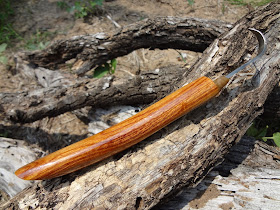


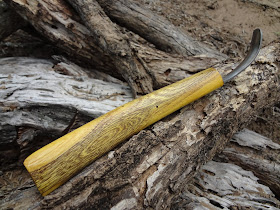
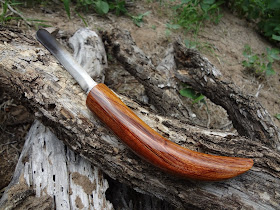




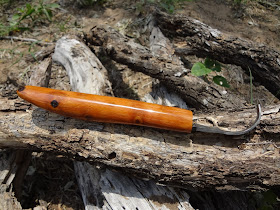
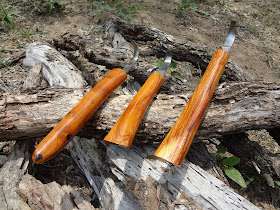
Very nice knives, I enjoyed the tour.
ReplyDeleteYou can't beat beauty and function!
A couple of blog ideas for you:
How to dry your spoon carvings without them cracking?
How to mount your hook blades to the handle?
I look forward to your future posts, thanks for putting them up and sharing, Doug.
Ah yes, cracks and checks occurring when making spoons. I'll post something on that as well as another post on mounting hook blades to a handle.
ReplyDeleteThanks
It's really an amazing knife with wonderful handle. I also like the handle and shape of this wooden knife.
ReplyDeleteout of the front knife
The crooked knife is one of my favorite knives. I seldom go a week without using one on various projects. In fact, I just got through making a couple of bows and used crooked knives in the process.
Deletedragkrok It is perfect time to make some plans for the future and it is time to be happy. I’ve read this post and if I could I desire to suggest you few interesting things or tips. Perhaps you could write next articles referring to this article. I want to read more things about it!
ReplyDelete